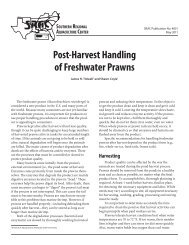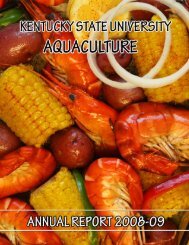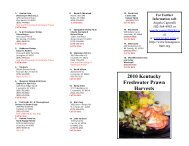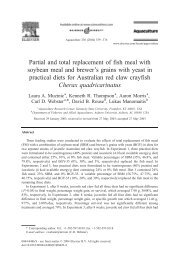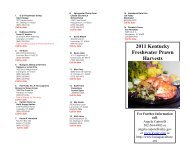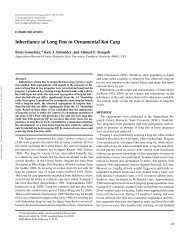Aquatic Weed Control in Ponds - Aquaculture at Kentucky State ...
Aquatic Weed Control in Ponds - Aquaculture at Kentucky State ...
Aquatic Weed Control in Ponds - Aquaculture at Kentucky State ...
Create successful ePaper yourself
Turn your PDF publications into a flip-book with our unique Google optimized e-Paper software.
Handle herbicides safelyAlthough aqu<strong>at</strong>ic herbicides arerel<strong>at</strong>ively safe to handle, it isnevertheless important for applic<strong>at</strong>ors tokeep chemical exposure to an absolutem<strong>in</strong>imum. Herbicide labels and m<strong>at</strong>erialsafety d<strong>at</strong>a sheets advise wh<strong>at</strong> protectivecloth<strong>in</strong>g and equipment should be worn,any precautions the handler shouldfollow, a st<strong>at</strong>ement of practical tre<strong>at</strong>ment<strong>in</strong> case of poison<strong>in</strong>g, st<strong>at</strong>ementsconcern<strong>in</strong>g hazards to the environment,any physical or chemical hazards, anddirections on proper storage anddisposal. By law, copies of labels andany supplementary labels must be <strong>in</strong> thepossession of the applic<strong>at</strong>or <strong>at</strong> theapplic<strong>at</strong>ion site for each herbicide used.Anyone who handles a pesticide mustread and understand all label st<strong>at</strong>ementsprior to us<strong>in</strong>g the product. Herbicidesafety is reviewed <strong>in</strong> SRAC public<strong>at</strong>ion3601 which can be found <strong>at</strong>www.msst<strong>at</strong>e.edu/dept/srac .Dispose of herbicide conta<strong>in</strong>ersproperlyImproper disposal of herbicideconta<strong>in</strong>ers can cause contam<strong>in</strong><strong>at</strong>ion ofsoil and w<strong>at</strong>er, and may result <strong>in</strong> f<strong>in</strong>es orloss of an applic<strong>at</strong>or’s license. Emptyherbicide conta<strong>in</strong>ers must be tripler<strong>in</strong>sed, with each r<strong>in</strong>s<strong>in</strong>g dra<strong>in</strong>ed <strong>in</strong>to theherbicide mix tank. If no mix tank isused, the r<strong>in</strong>se w<strong>at</strong>er from the conta<strong>in</strong>ershould be applied to the pond <strong>in</strong> thesame manner as the herbicide <strong>in</strong> theconta<strong>in</strong>er. Conta<strong>in</strong>ers must then bepunctured or crushed so th<strong>at</strong> they can notbe reused. Empty bags must be r<strong>in</strong>sed orshaken clean and cut so th<strong>at</strong> they can notbe used for other purposes. Lawsregard<strong>in</strong>g disposal of r<strong>in</strong>sed conta<strong>in</strong>ersvary among st<strong>at</strong>es, so be sure to followall st<strong>at</strong>e and local regul<strong>at</strong>ions regard<strong>in</strong>gpesticide conta<strong>in</strong>er disposal.Two aqu<strong>at</strong>ic herbicides, 2,4-Dand endothall, are regul<strong>at</strong>ed as hazardousm<strong>at</strong>erials under federal law, and anywaste gener<strong>at</strong>ed dur<strong>in</strong>g their use must bedisposed of as hazardous waste. Tripler<strong>in</strong>sedconta<strong>in</strong>ers can be disposed of aswith any other pesticide conta<strong>in</strong>er. Anyr<strong>in</strong>se w<strong>at</strong>er from clean<strong>in</strong>g of conta<strong>in</strong>ersor applic<strong>at</strong>ion equipment must beapplied as if it were the herbicide ordisposed of <strong>at</strong> a hazardous wastedisposal facility.Consequences of herbicide useWhen used accord<strong>in</strong>g to themanufacturer’s specific<strong>at</strong>ions, herbicidesare seldom directly toxic to fish.However, the addition of any herbicideto a plant-<strong>in</strong>fested body of w<strong>at</strong>er willalter w<strong>at</strong>er quality. Oxygen productionby photosynthesis will be decreased anddecomposition of the dead plant m<strong>at</strong>erialwill <strong>in</strong>crease oxygen consumption. Theresult will be a noticeable decrease <strong>in</strong>dissolved oxygen concentr<strong>at</strong>ionscompared to pretre<strong>at</strong>ment levels. Theextent to which dissolved oxygen levelsare reduced depends on the amount ofplant m<strong>at</strong>erial killed, the amount of plantm<strong>at</strong>erial unaffected by the herbicide, ther<strong>at</strong>e th<strong>at</strong> de<strong>at</strong>h occurs, w<strong>at</strong>er temper<strong>at</strong>ureand other factors. Decomposition of thedead plants will also raise carbondioxide and total ammoniaconcentr<strong>at</strong>ions. The <strong>in</strong>crease <strong>in</strong> totalammonia concentr<strong>at</strong>ions tends todecrease the pH, caus<strong>in</strong>g much of theammonia to be <strong>in</strong> the non-toxic, ionizedform. Phosphorus, potassium, and otherm<strong>in</strong>erals are also released upon plantdecomposition, and concentr<strong>at</strong>ions of allessential plant nutrients will usually behigher after herbicide tre<strong>at</strong>ment. Atsome time after tre<strong>at</strong>ment, theconcentr<strong>at</strong>ion of herbicide will decrease18



